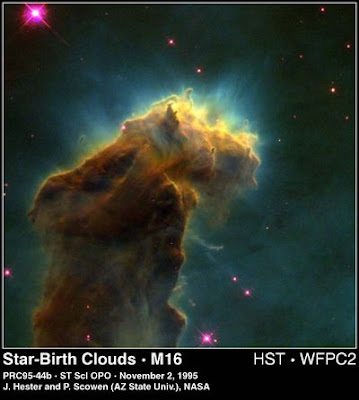Nebulae are typically classified as either bright or dark. Bright nebulae must be fairly close to nearby stars to glow. Dark nebulae require a brighter backdrop, such as a star cluster, to be visible. One of the most well-known dark nebulae is the Horsehead Nebula in the constellation Orion. There is also what is known as a reflection nebula, which is simply a dark nebula that reflects the light of nearby stars.
Nebulae are not just incredibly beautiful formations in the sky. They play a very important role in the evolution of the galaxies. Nebulae can be involved in both the birth and the death of stars.
One type of star death causes a planetary nebula, named as such because these nebulae are rounded and resemble planets. An aging star running low on hydrogen will begin to burn helium and swells to massive proportions. After the surface cools, this “red giant” is unstable. The outer layers of the star are thrown off, forming a planetary nebula. The core is a bluish-white color due to extremely high temperatures. It is the heat from this core that causes the nebula to glow. The Eskimo Nebula, discovered in 1787 by William Herschel, is an excellent example of a planetary nebula.
When a high-mass star dies, it will die not as a red giant but as a supernova. It this case, the star collapses inward on itself. The gas coming back into the inner layer of the star gets so super-heated that it is bounced back out in a major explosion, forming a visible nebula. The most studied supernova is the Crab Nebula, discovered by Arab and Chinese astronomers in 1054. The supernova became so bright that for 23 days it was visible even during the day. It remained visible to the naked eye for approximately two YEARS.
The Hubble Telescope has been instrumental in helping us to better understand nebulae, along with the outer reaches of space we didn’t even know existed many years ago. Imagine what will be learned over the next hundreds or thousands of years as technology continues to improve and expand our horizons.
The following is a small collection of nebulae from the NASA archives.
Author Resource: Written by Starr Hendon














No comments:
Post a Comment